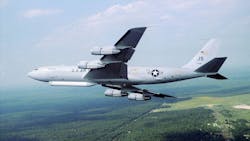Northrop Grumman to upgrade 17 Joint STARS legacy radar surveillance aircraft in half-billion-dollar deal
ROBINS AIR FORCE BASE, Ga. – Surveillance radar experts at Northrop Grumman Corp. will upgrade and maintain 17 E-8C Joint Surveillance Target Attack Radar System (Joint STARS) aircraft under terms of a contract announced Friday worth nearly a half billion dollars.
Officials of the U.S. Air Force Life Cycle Management Center at Robins Air Force Base, Ga., are awarding a $495 million contract to the Northrop Grumman Aerospace Systems segment in Melbourne, Fla., to modernize and sustain 16 mission and one trainer Joint STARS aircraft.
Northrop Grumman is the prime contractor for the Joint STARS, a modified Boeing 707 single-aisle commercial passenger jet that detects, locates, classifies, tracks, and targets hostile ground movements, and communications real-time information through secure data links.
Joint STARS uses a sophisticated radar system that can scan an entire region and then send the data to a computer which analyzes movement and alerts reconnaissance specialists of any suspicious activity in near-real time.
Operators onboard the aircraft can provide ground and air commanders with command and control, intelligence, surveillance, and reconnaissance information on ground-based enemy activities from hundreds of miles away.
With the ability to see vehicle movement around the clock and in any weather conditions, the system provides information to ground and air commanders that enable friendly forces to delay, disrupt, and destroy their enemy.
The reliability, fuel efficiency, and increased operational effectiveness inherent in the engine upgrade translates to increased Joint STARS availability to the warfighter and decreased costs. Replacing all of the engines in the Joint STARS fleet will pay for itself through the reduced operation and maintenance costs of the current engines.
The Joint STARS aircraft started receiving new Pratt & Whitney's JT-8D-219 jet engines in 2008 to provide added power generation for future upgrades to the radar sensor and mission equipment. An Air Force study indicated the fleet could stay in service beyond 2050 because of the investment made when the airframes were refurbished during production.
Despite the upgrades to the Joint STARS over the past several years, some defense experts say the aircraft is a prime target for budget cuts in the 2021 U.S. defense budget, which should be presented to Congress next February.
The aircraft is based on an airframe from the 1950s and '60s, and is fantastically expensive to operate. With advances in electronics miniaturization and performance, the plane could be replaced with a new system based on a business jet configuration, which could help reduce costs and manning requirements.
On this contract Northrop Grumman will do the job at Robins Air Force Base, Ga., and should be finished by September 2024. For more information contact Northrop Grumman Aerospace Systems online at www.northropgrumman.com, or the Air Force Life Cycle Management Center-Robins at www.robins.af.mil/Units/AFLCMC.
About the Author
John Keller
Editor-in-Chief
John Keller is the Editor-in-Chief, Military & Aerospace Electronics Magazine--provides extensive coverage and analysis of enabling electronics and optoelectronic technologies in military, space and commercial aviation applications. John has been a member of the Military & Aerospace Electronics staff since 1989 and chief editor since 1995.
